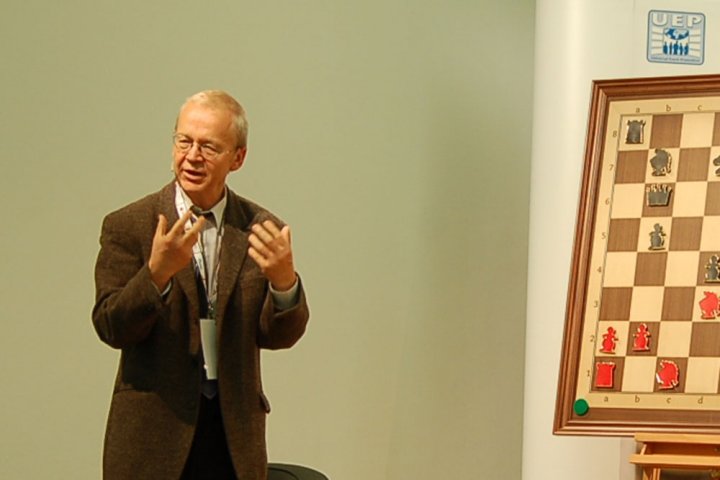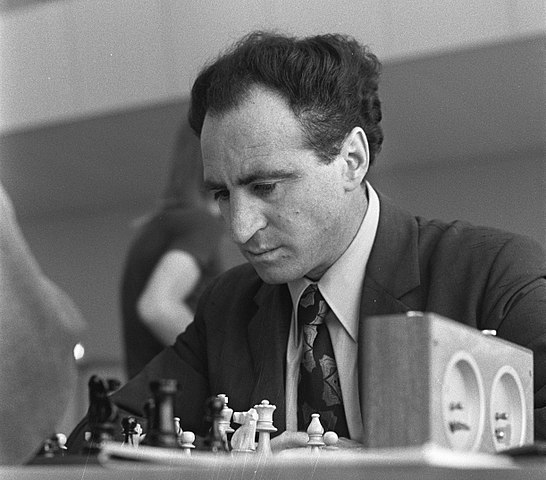


Lev Polugaevsky (* 20 November 1934 in Mogilev; † 30 August 1995 in Paris) was a world-class player and several times World Championship candidate. In July 1972 and January 1976 he shared third place in the world rankings together with Tigran Petrosian, and in 1973, 1976 and 1979 he qualified for the Candidate Matches in Interzonal tournaments. Polugaevsky won the Soviet Championship no less than three times - in 1967 (together with Mihail Tal), 1968 and 1969 (together with Petrosian) - and was considered an excellent theoretician and, above all, a great expert of the Sicilian defence.

Lev Polugaevsky | Photo: Rob Croes / Anefo [CC0], Wikimedia Commons
He was particularly enamored with a double-edged line of the Najdorf-Sicilian (1.e4 c5 2.Nf3 d6 3.d4 cxd4 4.Nxd4 Nf6 5.Nc3 a6 6.Bg5 e6 7.f4 b5!?), the Polugaevsky variation, which was named after him. Despite all the setbacks he suffered in this line and without being afraid that his opponents might prepare a tactical surprise, Polugaevsky used "his" variation again and again and tried for years – and without the help of a computer – to prove that the black position is playable after 7...b5. Polugaevsky told the story of his analyses of this variation in his book "Grandmaster Preparation", a still remarkable opening book, which is a testimony to Polugaevsky's work ethic, his approach to chess and his enthusiasm for the game.
Helmut Pfleger (born on August 6, 1943 in Teplitz-Schönau, in the Sudetenland) lacked the time for such profound theoretical investigations. Since the mid-1960s he had been one of the best players of West Germany, but focused first on his medical studies and then on his work as a doctor. In 1965 he became International Master, in 1971 he finished his PhD in medicine and subsequently worked in Munich as an internist and psychotherapist. He became Grandmaster in 1975.
In the first meeting between Pfleger and Polugaevsky, however, theoretical knowledge did not play a major role. At the 1968 Olympics in Lugano they agreed on a draw after only 13 moves.
A year later, at a tournament in Ludwigsburg in 1969, the two clashed for the second time, and in this game Pfleger lost quickly.
Polugaevsky liked this game so much that he later included it in his game collection Grandmaster Performance.
Pfleger also had Black in the third game of the two, which was played at a tournament in Tallinn in March 1973. Again, he came under pressure in the opening, and soon ended up in a queenless middlegame, which led to a worse endgame that Pfleger could not hold.
As chance would have it, Pfleger was Black again in the fourth game against Polugaevsky, which was played in August 1975 at a tournament in Montilla, Spain. After a draw and two losses from their first three games, he had to come up with something to beat the well-prepared theorist Polugaevsky. Pfleger opted for a new concept in the Tarrasch Defense, which promised Black good tactical possibilities and chances of counterplay. A good choice: Polugaevsky was unfamiliar with the subtleties of this variation and could not get Black's counterattack under control.
Today, the concept with 9...c4 is often played and games like this explain why Erwin l'Ami recommends this line in his DVD on the Tarrasch Defense.
In total, Pfleger and Polugaevsky met six times, and in the only game, in which Pfleger had White, was at a tournament in Manila in October 1975. It ended in a draw after 22 moves and did not offer much excitement.
Pfleger and Polugaevsky played their sixth, last and most significant game at the Chess Olympiad 1978 in Buenos Aires. Pfleger was Black for the fifth time and, unsurprisingly, Polugaevsky, who had great confidence in his opening variations and opening analyses, repeated the theoretical discussion in the Tarrasch Defense, with which he had suffered shipwreck three years earlier against the same opponent. But again, the line Polugaevsky chose to play did not bring him any luck. Once again Pfleger understood the tactical nuances of the position better and Polugaevsky lost again.
This game was not only theoretically significant, but also historically important: it was played in the 9th round of the Chess Olympiad in the match between West Germany and the USSR and it helped the German team to a surprising 2.5:1.5 victory against the heavily favoured Soviets. This unexpected defeat threw the the Soviet team, who in the previous eight rounds of the Olympics had only lost a single team point after a 2-2 draw against England, out of rhythm. After the setback against Germany, the Soviet team failed to get more than two 2-2 draws with Israel in Round 10 and Sweden in Round 11, and ended up in second place with 23 team points and 36 board points. The gold medal went to the Hungarians who also had scored 23 team points but 37 board points, one more than the Soviets. A bitter and historic defeat for the usually successful Soviets.
From the 1952 Chess Olympiad in Helsinki to the 1990 Chess Olympiad in Novi Sad the Soviet Union had always won gold, except for the Olympiad 1976 in Haifa, which the USSR had boycotted for political reasons, and the Olympiad in Buenos Aires 1978. Pfleger's victory in the theoretical duel against Polugaevsky contributed significantly to this historic failure of the Soviets.
Translated from German by Arthur Paul